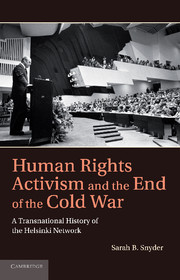Book contents
- Frontmatter
- Contents
- Acknowledgments
- Introduction
- 1 Bridging the East–West Divide
- 2 “A Sort of Lifeline”
- 3 Even in a Yakutian Village
- 4 Follow-up at Belgrade
- 5 Helsinki Watch, the IHF, and the Transnational Campaign for Human Rights in Eastern Europe
- 6 Human Rights in East–West Diplomacy
- 7 “A Debate in the Fox Den About Raising Chickens”
- 8 “Perhaps Without You, Our Revolution Would Not Be”
- Conclusion
- Bibliography
- Index
Conclusion
Published online by Cambridge University Press: 01 June 2011
- Frontmatter
- Contents
- Acknowledgments
- Introduction
- 1 Bridging the East–West Divide
- 2 “A Sort of Lifeline”
- 3 Even in a Yakutian Village
- 4 Follow-up at Belgrade
- 5 Helsinki Watch, the IHF, and the Transnational Campaign for Human Rights in Eastern Europe
- 6 Human Rights in East–West Diplomacy
- 7 “A Debate in the Fox Den About Raising Chickens”
- 8 “Perhaps Without You, Our Revolution Would Not Be”
- Conclusion
- Bibliography
- Index
Summary
The largely peaceful collapse of communism in Eastern Europe in 1989, the reunification of Germany in 1990, and the disintegration of the Soviet Union in 1991 traditionally signify the end of the Cold War, which had dominated international relations for more than forty-five years. The end of the Cold War has been attributed to a multitude of factors including economic decline, imperial overstretch, military competition, nationalism, the transmission of Western culture, scientific and educational contacts, and the personalities of key political leaders, among others. I have argued that the Helsinki process and the transnational network of human rights advocates also contributed to the transformation of Europe, and that the development of this network established human rights as an integral component of international relations. My research shows that the Helsinki process directly and indirectly influenced both Western and Eastern governments to pursue policies that facilitated the rise of organized dissent in Eastern Europe, freedom of movement for East Germans, and improved human rights practices in the Soviet Union – all factors in the end of the Cold War. Finally, I have suggested that January 19, 1989, may be the appropriate date to consider as the end of the Cold War; on that day CSCE representatives agreed to the Vienna Concluding Document, which included legitimate commitments to enhance religious freedom, facilitate the spread of information, and address human rights and human contacts in three subsequent conferences.
- Type
- Chapter
- Information
- Human Rights Activism and the End of the Cold WarA Transnational History of the Helsinki Network, pp. 244 - 250Publisher: Cambridge University PressPrint publication year: 2011

